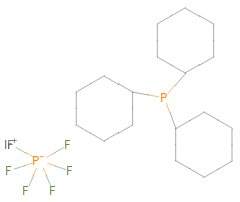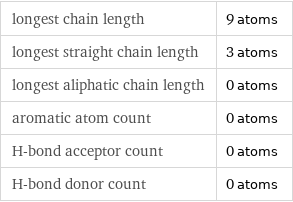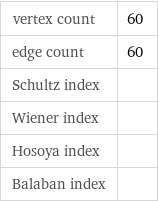Input interpretation

(tricyclohexylphosphine)-iridium(I) hexafluorophosphate
Basic properties
(F)(F)(F)F.[Ir+] InChI identifier | InChI=1/C18H33P.F6P.Ir/c1-4-10-16(11-5-1)19(17-12-6-2-7-13-17)18-14-8-3-9-15-18;1-7(2, 3, 4, 5)6;/h16-18H, 1-15H2;;/q;-1;+1 InChI key | KWTYIVOEYOILBZ-UHFFFAOYSA-N](../image_source/cccb89c41ab742a352b21009cbad32e2.png)
molar mass | 617.6 g/mol formula | C_18H_33F_6IrP_2 empirical formula | F_6P_2Ir_C_18H_33 SMILES identifier | C1CCC(CC1)P(C2CCCCC2)C3CCCCC3.F[P-](F)(F)(F)(F)F.[Ir+] InChI identifier | InChI=1/C18H33P.F6P.Ir/c1-4-10-16(11-5-1)19(17-12-6-2-7-13-17)18-14-8-3-9-15-18;1-7(2, 3, 4, 5)6;/h16-18H, 1-15H2;;/q;-1;+1 InChI key | KWTYIVOEYOILBZ-UHFFFAOYSA-N
Structure diagram

Structure diagram
Quantitative molecular descriptors

longest chain length | 9 atoms longest straight chain length | 3 atoms longest aliphatic chain length | 0 atoms aromatic atom count | 0 atoms H-bond acceptor count | 0 atoms H-bond donor count | 0 atoms
Elemental composition

Find the elemental composition for (tricyclohexylphosphine)-iridium(I) hexafluorophosphate in terms of the atom and mass percents: atom percent = N_i/N_atoms × 100% mass percent = (N_im_i)/m × 100% Plan: • Write the chemical formula and gather atomic masses from the periodic table. • Determine values for N_i, m_i, N_atoms and m using these items. • Finally, compute the percents and check the results. Write the chemical formula: C_18H_33F_6IrP_2 Use the chemical formula, C_18H_33F_6IrP_2, to count the number of atoms, N_i, for each element and find the total number of atoms, N_atoms: | number of atoms F (fluorine) | 6 P (phosphorus) | 2 Ir (iridium) | 1 C (carbon) | 18 H (hydrogen) | 33 N_atoms = 6 + 2 + 1 + 18 + 33 = 60 Divide each N_i by N_atoms to calculate atom fractions. Then use the property that atom fractions must sum to one to check the work: | number of atoms | atom fraction F (fluorine) | 6 | 6/60 P (phosphorus) | 2 | 2/60 Ir (iridium) | 1 | 1/60 C (carbon) | 18 | 18/60 H (hydrogen) | 33 | 33/60 Check: 6/60 + 2/60 + 1/60 + 18/60 + 33/60 = 1 Compute atom percents using the atom fractions: | number of atoms | atom percent F (fluorine) | 6 | 6/60 × 100% = 10.00% P (phosphorus) | 2 | 2/60 × 100% = 3.33% Ir (iridium) | 1 | 1/60 × 100% = 1.67% C (carbon) | 18 | 18/60 × 100% = 30.0% H (hydrogen) | 33 | 33/60 × 100% = 55.0% Look up the atomic mass, m_i, in unified atomic mass units, u, for each element in the periodic table: | number of atoms | atom percent | atomic mass/u F (fluorine) | 6 | 10.00% | 18.998403163 P (phosphorus) | 2 | 3.33% | 30.973761998 Ir (iridium) | 1 | 1.67% | 192.217 C (carbon) | 18 | 30.0% | 12.011 H (hydrogen) | 33 | 55.0% | 1.008 Multiply N_i by m_i to compute the mass for each element. Then sum those values to compute the molecular mass, m: | number of atoms | atom percent | atomic mass/u | mass/u F (fluorine) | 6 | 10.00% | 18.998403163 | 6 × 18.998403163 = 113.990418978 P (phosphorus) | 2 | 3.33% | 30.973761998 | 2 × 30.973761998 = 61.947523996 Ir (iridium) | 1 | 1.67% | 192.217 | 1 × 192.217 = 192.217 C (carbon) | 18 | 30.0% | 12.011 | 18 × 12.011 = 216.198 H (hydrogen) | 33 | 55.0% | 1.008 | 33 × 1.008 = 33.264 m = 113.990418978 u + 61.947523996 u + 192.217 u + 216.198 u + 33.264 u = 617.616942974 u Divide the mass for each element by m to calculate mass fractions. Then use the property that mass fractions must sum to one to check the work: | number of atoms | atom percent | mass fraction F (fluorine) | 6 | 10.00% | 113.990418978/617.616942974 P (phosphorus) | 2 | 3.33% | 61.947523996/617.616942974 Ir (iridium) | 1 | 1.67% | 192.217/617.616942974 C (carbon) | 18 | 30.0% | 216.198/617.616942974 H (hydrogen) | 33 | 55.0% | 33.264/617.616942974 Check: 113.990418978/617.616942974 + 61.947523996/617.616942974 + 192.217/617.616942974 + 216.198/617.616942974 + 33.264/617.616942974 = 1 Compute mass percents using the mass fractions: Answer: | | | number of atoms | atom percent | mass percent F (fluorine) | 6 | 10.00% | 113.990418978/617.616942974 × 100% = 18.46% P (phosphorus) | 2 | 3.33% | 61.947523996/617.616942974 × 100% = 10.03% Ir (iridium) | 1 | 1.67% | 192.217/617.616942974 × 100% = 31.12% C (carbon) | 18 | 30.0% | 216.198/617.616942974 × 100% = 35.01% H (hydrogen) | 33 | 55.0% | 33.264/617.616942974 × 100% = 5.386%
Elemental oxidation states

The first step in finding the oxidation states (or oxidation numbers) in (tricyclohexylphosphine)-iridium(I) hexafluorophosphate is to draw the structure diagram. Next set every oxidation number equal to the atom's formal charge: In (tricyclohexylphosphine)-iridium(I) hexafluorophosphate hydrogen is not bonded to a metal with lower electronegativity, so it will have an oxidation state of +1. Any element bonded to hydrogen gains the bonding electrons, decreasing their oxidation state by 1 for every bond: With hydrogen out of the way, look at the remaining bonds. There are 3 carbon-phosphorus bonds, 6 fluorine-phosphorus bonds, and 18 carbon-carbon bonds. For each of these bonds, assign the bonding electrons to the most electronegative element. First examine the carbon-phosphorus bonds: element | electronegativity (Pauling scale) | C | 2.55 | P | 2.19 | | | Since carbon is more electronegative than phosphorus, the electrons in these bonds will go to carbon. Decrease the oxidation number for carbon in every highlighted bond (by 1 for single bonds, 2 for double bonds, and 3 for triple bonds), and increase the oxidation number for phosphorus accordingly: Next look at the fluorine-phosphorus bonds: element | electronegativity (Pauling scale) | F | 3.98 | P | 2.19 | | | Since fluorine is more electronegative than phosphorus, the electrons in these bonds will go to fluorine: Next look at the carbon-carbon bonds: element | electronegativity (Pauling scale) | C | 2.55 | C | 2.55 | | | Since these elements are the same the bonding electrons are shared equally, and there is no change to the oxidation states: Now summarize the results: Answer: | | oxidation state | element | count -2 | C (carbon) | 18 -1 | F (fluorine) | 6 +1 | H (hydrogen) | 33 | Ir (iridium) | 1 +3 | P (phosphorus) | 1 +5 | P (phosphorus) | 1
Topological indices

vertex count | 60 edge count | 60 Schultz index | Wiener index | Hosoya index | Balaban index |